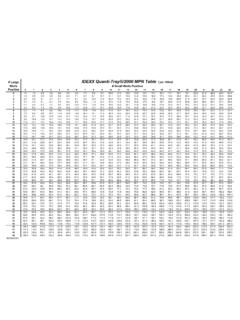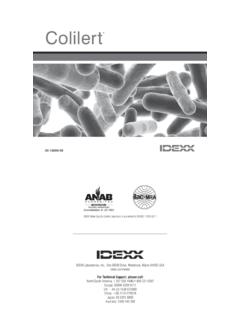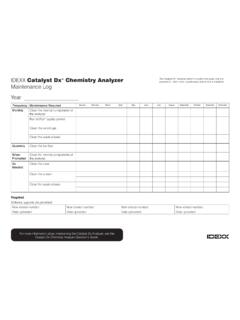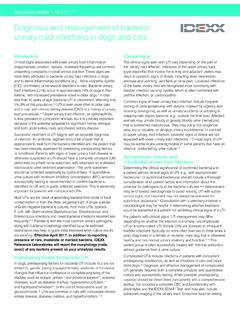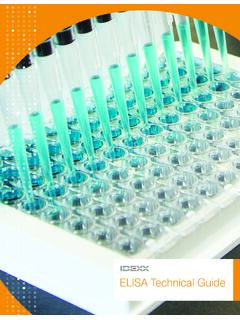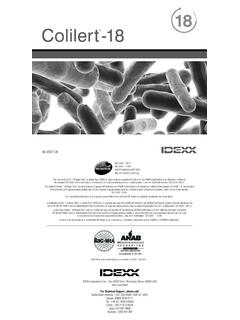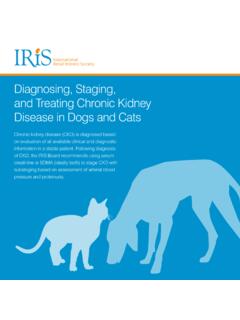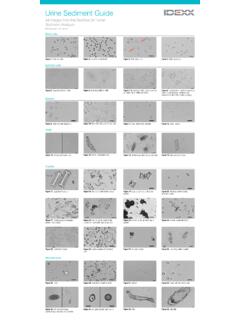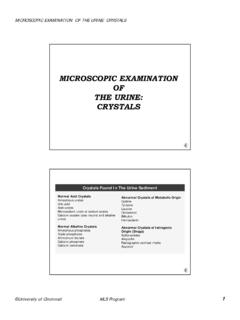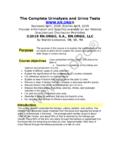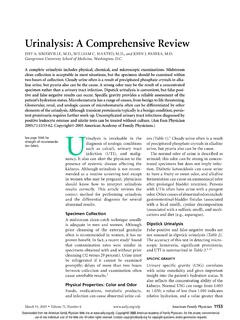Transcription of IDEXX SDMA algorithm
1 Reflects other disease processes affecting the kidneys6 Examples: Hypertension Severe dehydration Toxicity ( , NSAIDs, ethylene glycol, lilies) Hyperthyroidism (feline)Evaluate patient in 6 monthsImpaired GFR: ACT NOWD etects diseases of the kidney sooner1 3 Examples: Chronic kidney disease (CKD) see International Renal Interest Society (IRIS) guidelines Acute kidney injury Pyelonephritis NoYe sIDEXX SDMA algorithmAn elevated SDMA* concentration is a reflection of impaired glomerular filtration rate (GFR). Both primary kidney disease and secondary kidney insults, such as concurrent disease, can cause an elevation in SDMA concentration. Follow this algorithm to investigate elevated SDMA concentrations and determine whether acute, active, or chronic injury is occurring and how to begin to investigate, manage, and monitor reverse for the initial steps in investigating, managing, and monitoring impaired GFR as identified by an elevated SDMANote: Puppy reference interval 0 16 g/dLIDEXX SDMAELEVATED14 Persistent elevation in SDMA concentrationRecheck kidney panel in 2 4 weeks(minimum of SDMA, BUN, creatinine, phosphorus, urinalysis)No Polyuria/polydipsia (PU/PD) Anorexia or weight loss Abnormal kidney palpation or imaging HypertensionOther evidence of decreased GFR or kidney disease?
2 Elevated BUN, creatinine, or phosphorus Creatinine increasing within the reference interval Inappropriate urine specific gravity Active urine sediment Proteinuria (inactive sediment )Evaluate complete urinalysis15 19 g/dL and/or20 g/dL Underlying causeUrinary tract infection (UTI)/pyelonephritisToxicity ( , NSAIDs, ethylene glycol, lilies)Acute kidney InjurySystemic hypertensionChronic kidney disease (CKD)Treat appropriatelyUnderlying disease ( , pyelonephritis, infectious disease)DehydrationDiscontinue nephrotoxic medications ( , NSAIDs) HypertensionProteinuriaMonitor renal biomarkersTrended testing of the following:SDMA, BUN, creatinine, and phosphorusUrinalysisBlood pressure Additional supportAmple, clean waterKidney-supportive diet if warrantedSDMA remains increased, but stableGFR remains impaired but stableConsider CKD diagnosis, refer to IRIS staging and treatment guidelinesInstitute appropriate supportive care and monitoringSDMA continues to increaseOngoing active kidney injuryRevisit investigate: repeat or perform additional diagnosticsInstitute ongoing supportive careSDMA returns to normalRecovery from mild injuryResponse to appropriate therapyCompensatory mechanismsRecheck within 6 months 1 yearOutcomeGFR impairment, progressiveGFR restorationAdjust anesthesia protocolsProvide fluids (intravenous or subcutaneous)Oxygen support prior to, during, and after procedureAdjust pain managementConsider performingUrine culture and minimum inhibitory concentration (MIC) susceptibilityInfectious disease testingAbdominal imagingUrine protein.
3 Creatine (UPC) ratio (proteinuria)Blood pressure Concurrent condition to assessHydration statusThyroid status (feline) Initial steps in investigating, managing, and monitoring impaired GFR as identified by an elevated SDMAR emember that patients can move back to an investigation stage from management or monitoring depending on progression or change in renal cause, treatable condition, concurrent disease, chronic kidney disease (CKD)Treat underlying disease, manage assessed kidney injury, adjust care protocolsManage and monitor outcomes* Symmetric a complete list of references, visit information contained herein is intended to provide general guidance only. As with any diagnosis or treatment, you should use clinical discretion with each patient based on a complete evaluation of the patient, including history, physical presentation, and complete laboratory data. With respect to any drug therapy or monitoring program, you should refer to product inserts for a complete description of dosages, indications, interactions, and cautions.
4 Diagnosis and treatment decisions are the ultimate responsibility of the primary care veterinarian. 2019 IDEXX Laboratories, Inc. All rights reserved. 09-81145-05 All /TM marks are owned by IDEXX Laboratories, Inc. or its affiliates in the United States and/or other countries. The IDEXX Privacy Policy is available at impairment, stabl

